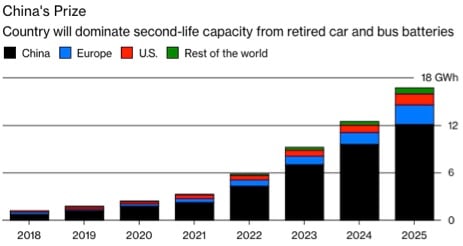By 2040, more than half of new-car sales and a third of the global fleet—equal to 559 million vehicles—is projected to be electric. This poses serious challenges. Electric vehicle batteries typically must be replaced every seven to 10 years for smaller vehicles and three to four for larger ones, such as buses and vans. Declining performance for an electric vehicle battery is evidenced by fewer miles of driving per charge and more frequent plug-ins by owners. The global stockpile of these batteries is expected to exceed 3.4 million by 2025, compared with about 55,000 last year. This is almost a 62-fold increase in 7 years. Automobiles have overtaken consumer electronics as the biggest users of lithium-ion batteries. Because batteries contain toxic chemicals that should not be placed into a landfills, they need to be either recycled, which involves an intensive manufacturing process, or repurposed for other uses.
China has the largest electric vehicle market in the world and the largest number of electric vehicle manufacturers. Electric cars make sense in China because of its dense and crowded cities that often mean shorter driving distances. China, where about half the world’s electric vehicles are sold, has made carmakers responsible for expired batteries and the European Union also has regulations on battery disposal.
Recycling
Batteries can be recycled, but recycling them is not easy due to the sophisticated chemical procedures involved. If not handled properly, the heavy metal contained in the battery can lead to contamination of the soil and water.
Batteries can be recycled through smelting, direct recovery, and other, newer processes. A smelting process is used to recover many minerals (e.g. lithium, cobalt, nickel) contained in the battery. After a battery is smelted, the lithium ends up as a mixed byproduct and extracting it is costly. While the cost of fully recycling a lithium-ion battery is about €1 per kilogram, the value of the raw minerals reclaimed from the process is only about a third of that.Another way to look at the cost of extraction of lithium from old batteries is that it is 5 times more expensive than mined lithium.
One of the premier EV battery recycling companies is Li-Cycle, a Canada-based company that uses advanced recycling technologies that can recover up to 100 percent of lithium from lithium-ion batteries. In the United States, California-based Redwood Materials and Retriev Technologies also recycle materials from old batteries. OnTo Technology, based in Oregon, is also pioneering advanced battery recycling processes.
Repurposing
As these advanced technology processes continue to develop, reusing batteries offers another route to their disposal and productivity. Many electric vehicle batteries which are ‘spent’ still have up to 70 percent of their capacity left– more than enough for other uses. After used electric vehicle batteries have been broken down, tested, and re-packaged, they can be used for things like home energy storage.
Manufacturers like Nissan and Renault are using old batteries to provide new services. In Japan, Nissan repurposed batteries to power streetlights. Renault has batteries backing up elevators in Paris. And GM is backing up its data center in Michigan with used Chevy Volt batteries. Old batteries can also be useful for storing solar energy and backing up traditional electrical grids. In addition, private companies like the UK-based Powervault and Australia-based Aceleron have created technologies that can turn batteries into home electricity storage units, electric bike batteries, and other tools. General Motors Co., BMW AG, Toyota Motor Corp., BYD Co. and several renewable-energy storage suppliers are among those trying to create an aftermarket, thereby obtaining extra profits.
Source: Bloomberg
By 2025, it is estimated that about three-quarters of spent electric batteries will be reused and then recycled to harvest raw materials. That means automakers and battery producers can profit from the same battery pack several times.
Conclusion
Batteries have a limited life for electric vehicles. However, because they still have 70 percent of their capacity after electric vehicle use, there is a secondary market for them for home storage, street lights, elevators, data centers and other uses. Once these uses have expired, the battery can be recycled to obtain reusable materials, such as lithium, cobalt, and nickel. But, advanced processes are still needed to make recycling more economic. Several companies are working on the technology. However, if the electric vehicle market grows as these projections indicate, the resulting significant increase in the demand for battery and battery materials may be a major challenge for suppliers.
A previous IER article on battery disposal can be found here:




